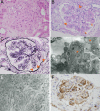Fibronectin glomerulopathy
- PMID: 26064516
- PMCID: PMC4438411
- DOI: 10.1093/ckj/sft097
Fibronectin glomerulopathy
Abstract
Fibronectin glomerulopathy occurs between the second and fifth decades of life in most patients, and it is known to be slowly progressive with mild proteinuria leading to kidney failure. The case of a 78-year-old woman with a rapid course of nephrotic syndrome due to fibronectin glomerulopathy is reported. She had proteinuria that rapidly increased to 6.8 g/day in a month and microscopic haematuria. A renal biopsy specimen showed lobular glomerulopathy and membranoproliferative glomerulonephritis-like lesions on light microscopy. There was scanty staining for immunoglobulins and complement. Electron microscopy revealed granular deposits with fibril formation. Immunohistochemistry of the fibronectin showed intense staining in the mesangium and peripheral loop. Therefore, this case was diagnosed as fibronectin glomerulopathy. The kidney function was rapidly decreasing, necessitating haemodialysis 2 months after renal biopsy. It is important to consider fibronectin glomerulopathy in the differential diagnosis of nephrotic syndrome in older people.
Keywords: fibronectin glomerulopathy; haemodialysis; nephrotic syndrome.
Figures

References
-
- Gemperle O, Neuweiler J, Reutter FW, et al. Familial glomerulopathy with giant fibrillar (fibronectin-positive) deposits: 15-year follow-up in a large kindred. Am J Kidney Dis. 1996;28:668–675. - PubMed
-
- Weiss M, Tzavella K, Müller-Höcker J, et al. Fibrillary glomerulonephritis. Case report for differential nephrotic syndrome diagnosis. Pathology. 1998;19:141–145. - PubMed
LinkOut - more resources
Full Text Sources
Other Literature Sources

